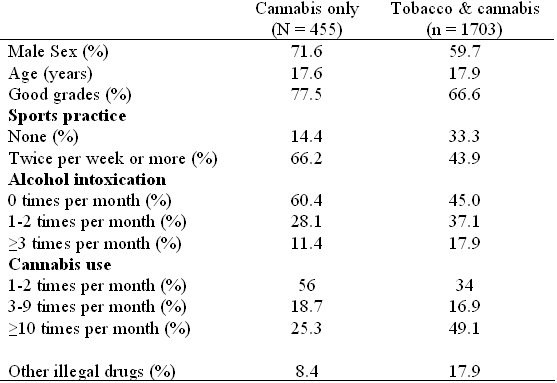The substances adolescents use correlates with unhealthy psychosocial functioning (e.g., Kirby, 2002). Information about the possible added effect of multiple substance use would help to clarify the association. This week’s ASHES reports a study that compared the prevalence of unhealthy psychosocial functioning markers among adolescents who use only cannabis to the prevalence among adolescents who use both cannabis and tobacco.
Method
- A Swedish national survey (Suris, Akre, Berchtold, Jeannin, & Michaud, 2007) queried 7548 students aged 16-20 about their substance use behavior and markers of psychosocial functioning, such as their academic performance.
- Researchers excluded from analyses: former tobacco smokers (n=342); occasional smokers (n=826); and daily smokers who have not used cannabis (n=1,117).
- Among cannabis users (n = 2158), the study compared adolescents who used tobacco (78.9%) to adolescents who did not (21.1%).
Results
The Figure shows that, compared to adolescents who used cannabis and tobacco, adolescents who only used cannabis, were:
- More likely to be male and were slightly but statistically significantly younger;
- More likely to have good grades, play sports; and
- Less likely to report having been drunk recently or having used cannabis frequently.

Figure. Multivariate analysis comparing tobacco smokers to non-smokers among cannabis users. Click image to enlarge.
Note: Significant differences between all variables (2-sample test of proportions at the 95% level).(Adapted from Suris et al., 2007)
Limitations
- The study uses self report.
- The study does not include adolescents who were not in school the day the researchers administered the survey. These missing people are likely school dropouts or truants who might have more substance use behaviors and poorer psychosocial markers. This suggests that these findings are conservative estimates of cannabis and tobacco use prevalence and sequelae.
- Using proxies for healthy psychosocial functioning, such as academic performance, might not be as sensitive as formal clinical assessment measures.
- The study is not longitudinal, so we cannot determine whether substance use initiation occurs in a progression. Older adolescents might be more likely to use tobacco and cannabis compared to younger adolescents.
- The time since onset of cannabis use could correlate with markers of poor functioning. Therefore, this study might actually assess differences in psychosocial markers as a function of age and tobacco use is a marker for age.
- This study, conducted in Sweden, might not generalize to youth in other, culturally dissimilar countries.
Conclusion
Although tobacco is easily available and more socially acceptable, when used with cannabis, it is an indicator of potential poor psychosocial functioning. Teachers, parents, and clinicians should be aware of the potential higher risk of poor functioning signaled by multiple substance use.
–Leslie Bosworth
References
Kirby, J. B. (2002). The influence of parental separation on smoking initiation in adolescents. Journal of Health and Social Behavior, 43(1), 56-71.
Suris, J. C., Akre, C., Berchtold, A., Jeannin, A., & Michaud, P.-A. (2007). Some go without a cigarette: Characteristics of cannabis users who have never smoked tobacco. Archives of Pediatric & Adolescent Medicine, 161(11), 1042-1047.
What do you think? Please use the comment link below to provide feedback on this article.




